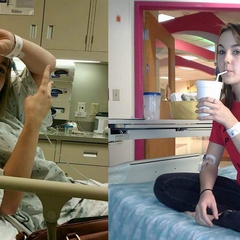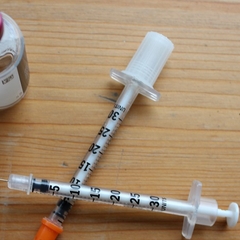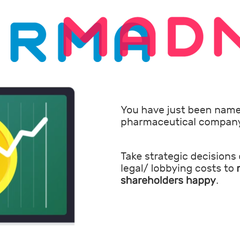
The Cold Cost of American Capitalism
1 Mar 2017, 5:17 p.m. in #insulin4all USA, Global Stories by Charles Murphy
I have been type 1 diabetic for fifteen years. I use Novolog insulin in my Medtronic pump to keep me alive on a daily basis. I began using Novolog in the spring after my insurance, Blue Cross Blue Shield of Wyoming, told me they would not cover the Humalog insulin I had been using since diagnosis. I would have to pay $947 for a month of insulin or go without paying rent to be able to continue using the insulin that I'd grown accustomed to using for fifteen years.
I found myself in a predicament, questioning the state of my health and my life because of the absurdities of the American healthcare system - again. I opted – perhaps I was forced – to make the switch to Novolog. I had heard it was very similar to Humalog, and this was the best chance I had at being able to afford my medication. Fortunately, I did not notice a huge difference in the way the two insulins metabolized. Neither the insurance companies nor the pharmaceutical companies seemed to care about the potential of an experiment with my life going wrong.
This was not the first time something like this had happened. It was simply the cherry on top. After eleven years of paying for most of my supplies out of pocket, I had finally obtained coverage through The Affordable Care Act (ACA), also called Obamacare. I finally felt that I was not going to get stripped of a future because of the cost of something I never asked for. With the appearance of the ACA, pharmaceuticals and insurance companies increasingly exploited the patients they were supposed to help by the order of the law.
Sure, I was protected from being denied for having a pre-existing condition, and I was protected from going bankrupt from surgery. I was not, however, protected from the unregulated industry that set the prices and premiums for the very supplies I needed to live.
I pay over three hundred dollars a month for a premium in addition to the cost of strips, insulin, and insulin pump supplies. It costs close to a third of my income to stay alive. That does not leave much room for rent, the cost of gas, and groceries. To say the least, there is not any room at all for luxuries such as travel or vacation.
I remember when my blood sugar dropped so low I fell into a seizure. I was forty miles from the closest hospital. My mother walked in on my episode and saved my life by splashing orange juice into my mouth. National Park rangers were already headed to my home by snowmobile. After they stabilized my blood sugar and evacuated me, I had to take an ambulance to the hospital in the nearest town. I did not have insurance at the time (my ACA benefits were due to kick in less than a week later).
In addition to the five hundred dollars a month I was already paying for insulin and testing supplies, I had to find a way to pay fifteen hundred dollars for an ambulance ride that I probably could have avoided. I should have steered clear of the ambulance, but I was experiencing memory problems and headaches so my mom insisted I go.
I don't blame her, but that did not make it any easier to pay the bill. The care I needed put me in financial a hole that took me the rest of the year to crawl out from. These episodes and incidents happen. It is the nature of Type 1 diabetes. When they do happen in the USA, the bills stack up. I recently turned down an ambulance ride so that whatever financial security I was gaining through Obamacare would not be dismantled.
Today, I am 'enjoying' the relative control I have over how much insulin is active in my blood at any given time by using an insulin pump. From the day of my diagnosis, this technology always evaded me because of my pre-existing condition. I pay fifty dollars for the cost of the pump every month, plus at least a hundred dollars each month for the supplies (fragile as they are) that deliver the insulin. These costs are in addition to the three hundred dollar premium I pay. Needless to say, my diabetes is expensive. Still, I have a shot at having a better quality of life because of the more intensive monitoring of insulin levels with the pump. Obamacare gave me the opportunity to have this better care.
Now, with the threat of Obamacare being repealed, pump therapy will be impossible. So will Continuous Glucose Monitoring. I will go back to paying over four hundred dollars a month just for insulin and only knowing what my sugar is when I prick my finger. What if I drop a vial and it breaks? More money into the pockets of the pharmaceutical companies.
It is very disconcerting to know that I will be back to taking multiple injections in my stomach every day after I have had this exposure to 'the good life' of pump therapy and having an idea of what my sugars are at all times. I will be forced to devolve into a life of unnecessary risk.
My life is a roller coaster ride of uncertainty. I just want the tools I need to manage my life and to experience a semblance of happiness. Instead, I am squabbling with insurance and pharmaceutical companies to provide the care that I believe is my natural human right. The injustices experienced by type 1 diabetics in this country amount to a form of massacre. But because there is an exchange of money involved, it is recognized as a form of capitalism. Even if there were a huge reduction in the costs of these supplies and insulin, the pharmaceuticals would continue to benefit.
People already experiencing a lower quality of life are increasingly pushed towards poverty. Why are the insulin companies being so bold as to continue to gouge these prices? This exploitation needs to stop now.
If you believe, like I do, that affordable insulin and diabetes supplies are a human right, you should sign the T1International Access Charter and learn more about their advocacy work to change the system. Even if you are new to advocacy but you know you want to make a chance, they have an advocacy toolkit to get you started. If we stand up for ourselves and for others who are even less fortunate, it is possible to secure a better future for all.








